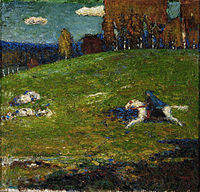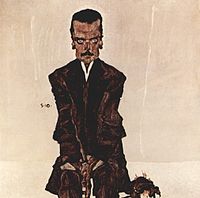Name applied to early 20th-century art (mainly northern European) where the artist’s state of mind is paramount when depicting the real world, which is thus often depicted in distorted forms. More a tendency than a style, it was based on the increasingly acceptable belief by the 1900s that expression is of primary importance and that the formal structure of a work creates the emotional impact. It may be viewed as a reaction against impressionism and Jugendstil.
Definitions vary as to the leading artists/ groups encompassed by this term; generally, the German artists MAX BECKMANN (1884-1950) and EMIL NOLDE (1867-1956) and Austrians OSKAR KOKOSCHKA (1886-1980) and EGON SCHIELE (1890-1918), as well as die brucke and blaue reiter artists form the core of Expressionism. To these can be added the French GEORGES ROUAULT (1871-1958), JULES PASCIN (1885-1930), ANDRé DENOYER de SEGONZAC (1884-1974) and the Ecole de Paris artists.
The term is occasionally applied to Fauves ANDRé DERAIN (1880-1954) and MAURICE VLAMINCK (1876-1958).
Expressionism is a modernist movement, initially in poetry and painting, originating in Northern Europe around the beginning of the 20th century. Its typical trait is to present the world solely from a subjective perspective, distorting it radically for emotional effect in order to evoke moods or ideas.[1][2] Expressionist artists have sought to express the meaning[3] of emotional experience rather than physical reality.[3][4]
Expressionism developed as an avant-garde style before the First World War. It remained popular during the Weimar Republic,[1] particularly in Berlin. The style extended to a wide range of the arts, including expressionist architecture, painting, literature, theatre, dance, film and music.[5]
The term is sometimes suggestive of angst. In a historical sense, much older painters such as Matthias Grünewald and El Greco are sometimes termed expressionist, though the term is applied mainly to 20th-century works. The Expressionist emphasis on individual and subjective perspective has been characterized as a reaction to positivism and other artistic styles such as Naturalism and Impressionism.[6]
Etymology



While the word expressionist was used in the modern sense as early as 1850, its origin is sometimes traced to paintings exhibited in 1901 in Paris by obscure artist Julien-Auguste Hervé, which he called Expressionismes.[7] An alternative view is that the term was coined by the Czech art historian Antonin Matějček in 1910 as the opposite of Impressionism: “An Expressionist wishes, above all, to express himself… (an Expressionist rejects) immediate perception and builds on more complex psychic structures… Impressions and mental images that pass through … people’s soul as through a filter which rids them of all substantial accretions to produce their clear essence […and] are assimilated and condense into more general forms, into types, which he transcribes through simple short-hand formulae and symbols.”[8]
Important precursors of Expressionism were the German philosopher Friedrich Nietzsche (1844–1900), especially his philosophical novel Thus Spoke Zarathustra (1883–1892); the later plays of the Swedish dramatist August Strindberg (1849–1912), including the trilogy To Damascus 1898–1901, A Dream Play (1902), The Ghost Sonata (1907); Frank Wedekind (1864–1918), especially the “Lulu” plays Erdgeist (Earth Spirit) (1895) and Die Büchse der Pandora (Pandora’s Box) (1904); the American poet Walt Whitman’s (1819–1892) Leaves of Grass (1855–1891); the Russian novelist Fyodor Dostoevsky (1821–1881); Norwegian painter Edvard Munch (1863–1944); Dutch painter Vincent van Gogh (1853–1890); Belgian painter James Ensor (1860–1949);[9] and pioneering Austrian psychoanalyst Sigmund Freud (1856–1939).[5]
In 1905, a group of four German artists, led by Ernst Ludwig Kirchner, formed Die Brücke (the Bridge) in the city of Dresden. This was arguably the founding organization for the German Expressionist movement, though they did not use the word itself. A few years later, in 1911, a like-minded group of young artists formed Der Blaue Reiter (The Blue Rider) in Munich. The name came from Wassily Kandinsky’s Der Blaue Reiter painting of 1903. Among their members were Kandinsky, Franz Marc, Paul Klee, and Auguste Macke. However, the term Expressionism did not firmly establish itself until 1913.[10] Though mainly a German artistic movement initially[11][5] and most predominant in painting, poetry and the theatre between 1910 and 1930, most precursors of the movement were not German. Furthermore, there have been expressionist writers of prose fiction, as well as non-German-speaking expressionist writers, and, while the movement had declined in Germany with the rise of Adolf Hitler in the 1930s, there were subsequent expressionist works.
Expressionism is notoriously difficult to define, in part because it “overlapped with other major ‘isms’ of the modernist period: with Futurism, Vorticism, Cubism, Surrealism and Dadaism.”[12] Richard Murphy also comments, “the search for an all-inclusive definition is problematic to the extent that the most challenging expressionists such as Kafka, Gottfried Benn and Döblin were simultaneously the most vociferous ‘anti-expressionists.'”[13]
What can be said, however, is that it was a movement that developed in the early twentieth century, mainly in Germany, in reaction to the dehumanizing effect of industrialization and the growth of cities, and that “one of the central means by which expressionism identifies itself as an avant-garde movement, and by which it marks its distance to traditions and the cultural institution as a whole is through its relationship to realism and the dominant conventions of representation.”[14] More explicitly, that the expressionists rejected the ideology of realism.[15]
The term refers to an “artistic style in which the artist seeks to depict not objective reality but rather the subjective emotions and responses that objects and events arouse within a person”.[16] It is arguable that all artists are expressive but there are many examples of art production in Europe from the 15th century onward which emphasize extreme emotion. Such art often occurs during times of social upheaval and war, such as the Protestant Reformation, German Peasants’ War, and Eighty Years’ War between the Spanish and the Netherlands, when extreme violence, much directed at civilians, was represented in propagandist popular prints. These were often unimpressive aesthetically but had the capacity to arouse extreme emotions in the viewer.
Expressionism has been likened to Baroque by critics such as art historian Michel Ragon[17] and German philosopher Walter Benjamin.[18] According to Alberto Arbasino, a difference between the two is that “Expressionism doesn’t shun the violently unpleasant effect, while Baroque does. Expressionism throws some terrific ‘fuck yous’, Baroque doesn’t. Baroque is well-mannered.”[19]
Groups of painters

Franz Marc, Rehe im Walde (Deer in Woods), 1914
The style originated principally in Germany and Austria. There were a number of groups of expressionist painters, including Der Blaue Reiter and Die Brücke. Der Blaue Reiter (The Blue Rider, named for a painting) was based in Munich and Die Brücke was originally based in Dresden (although some members later relocated to Berlin). Die Brücke was active for a longer period than Der Blaue Reiter, which was only together for a year (1912). The Expressionists were influenced by various artists and sources including Edvard Munch, Vincent van Gogh, and African art.[21] They were also aware of the work being done by the Fauves in Paris, who influenced Expressionism’s tendency toward arbitrary colours and jarring compositions. In reaction and opposition to French Impressionism, which emphasized the rendering of the visual appearance of objects, Expressionist artists sought to portray emotions and subjective interpretations. It was not important to reproduce an aesthetically pleasing impression of the artistic subject matter, they felt, but rather to represent vivid emotional reactions by powerful colours and dynamic compositions. Kandinsky, the main artist of Der Blaue Reiter group, believed that with simple colours and shapes the spectator could perceive the moods and feelings in the paintings, a theory that encouraged him towards increased abstraction.[5]
The ideas of German expressionism influenced the work of American artist Marsden Hartley, who met Kandinsky in Germany in 1913.[22] In late 1939, at the beginning of World War II, New York City received a great number of major European artists. After the war, Expressionism influenced many young American artists. Norris Embry (1921–1981) studied with Oskar Kokoschka in 1947 and during the next 43 years produced a large body of work in the Expressionist tradition. Norris Embry has been termed “the first American German Expressionist”. Other American artists of the late 20th and early 21st century have developed distinct styles that may be considered part of Expressionism. Another prominent artist who came from the German Expressionist “school” was Bremen-born Wolfgang Degenhardt. After working as a commercial artist in Bremen, he migrated to Australia in 1954 and became quite well known in the Hunter Valley region.
After World War II, figurative expressionism influenced worldwide a large number of artists and styles. In the U.S., American Expressionism[23] and American Figurative Expressionism, particularly Boston Expressionism,[24] were an integral part of American modernism around the Second World War. Thomas B. Hess wrote that “the ‘New figurative painting’ which some have been expecting as a reaction against Abstract Expressionism was implicit in it at the start, and is one of its most lineal continuities.”[25]
- Major figurative Boston Expressionists included: Karl Zerbe, Hyman Bloom, Jack Levine, David Aronson. The Boston Expressionists persisted after World War II despite their marginalization by the development of abstract expressionism centered in New York City, and are currently in the third generation.
- New York Figurative Expressionism[26][27] of the 1950s represented New York figurative artists such as Robert Beauchamp, Elaine de Kooning, Robert Goodnough, Grace Hartigan, Lester Johnson, Alex Katz, George McNeil (artist), Jan Muller, Fairfield Porter, Gregorio Prestopino, Larry Rivers and Bob Thompson.
- Lyrical Abstraction, Tachisme[28] of the 1940s and 1950s in Europe represented by artists such as Georges Mathieu, Hans Hartung, Nicolas de Staël and others.
- Bay Area Figurative Movement[29][30] represented by early figurative expressionists from the San Francisco area Elmer Bischoff, Richard Diebenkorn, and David Park. The movement from 1950 to 1965 was joined by Theophilus Brown, Paul Wonner, Hassel Smith, Nathan Oliveira, Jay DeFeo, Joan Brown, Manuel Neri, Frank Lobdell, and Roland Peterson.
- Abstract expressionism of the 1950s represented American artists such as Louise Bourgeois, Hans Burkhardt, Mary Callery, Nicolas Carone, Willem de Kooning, Jackson Pollock, Philip Guston, and others[31][32] that participated with figurative expressionism.
- Sōsaku-hanga (創作版画 “creative prints”) was an expressionist woodblock print movement in early 20th century Japan. The movement was characterized by the work of Kanae Yamamoto (artist), Kōshirō Onchi, and many others.
- In the United States and Canada, Lyrical Abstraction beginning during the late 1960s and the 1970s. Characterized by the work of Dan Christensen, Peter Young, Ronnie Landfield, Ronald Davis, Larry Poons, Walter Darby Bannard, Charles Arnoldi, Pat Lipsky and many others.[33][34][35]
- Neo-expressionism was an international revival style that began in the late 1970s

I’m impressed, I must say. Rarely do I come across a blog that’s both equally educative and interesting, and let me tell you, you have hit the nail on the head. The problem is something not enough men and women are speaking intelligently about. Now i’m very happy that I found this in my hunt for something concerning this.|